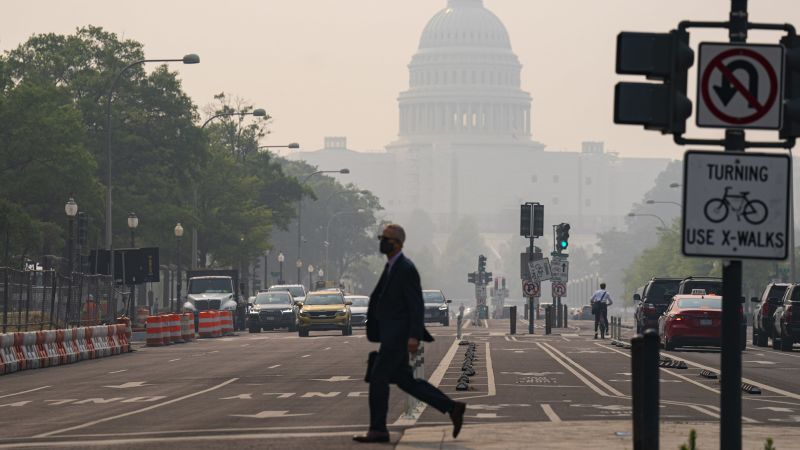Air quality over the US and Canada is improving after extreme wildfire conditions. But the smoke and altered skies will take time to clear
CNN —
Air quality conditions over much of the eastern US are forecast to slowly improve this weekend after plumes of harmful air from hundreds of wildfires in Canada traveled south, but schools in some metro areas will undergo remote learning Friday as officials remain on guard about pollution exposure.
While the most severe conditions have passed for most in the Northeast and Mid-Atlantic regions, potentially harmful air pollutants over cities including New York, Philadelphia and Washington, DC, are forecast to linger Friday before the areas slowly clear over the next several days.
“Smoke from Canadian wildfires continues to be transported south by winds into the U.S. resulting in moderate to unhealthy air quality across parts of the Northeast, Mid-Atlantic, Ohio Valley, and Midwest on Friday. Some improvement is expected this weekend,” the National Weather Service said.
The dense clouds of smoke have postponed professional sports games, grounded flights due to poor visibility, shuttered zoos and beaches as well as forced many to mask up when outdoors. Climate experts have warned such events are becoming more frequent due to human-induced climate change.
About 50 million people across several Midwest and East Coast states were under air quality alerts, but that number can change Friday as conditions improve for some.
Here’s what to expect Friday:
Entire states’ air quality is compromised : All of Pennsylvania, Delaware, Connecticut, Rhode Island, New Jersey and Indiana are under air quality alerts. Parts of Ohio, Michigan, Maryland, Virginia and North Carolina continue to experience those alerts as well.
Improvements in Canada : Most of the Halifax residents evacuated because of the wildfires will be allowed to return home Friday, Mayor Mike Savage said. About 16,000 people left their homes during the height of the wildfire evacuations and about 4,100 remain evacuated.
Schools going remote : The potentially dangerous conditions have led officials in New York City, the nation’s largest school system, and Philadelphia to implement remote learning Friday to help reduce exposure to air toxins.
New York City : After experiencing the world’s worst air quality at multiple points this week, the Big Apple could see some “significant improvement” Friday, Mayor Eric Adams said Thursday morning. “As of right now, the smoke models are not indicating another large plume over the city,” Adams noted as he urged people to mask well when outside.
Firefighting assistance: On Friday, New York state plans to send forest rangers to help fight the wildfires in Quebec, Gov. Kathy Hochul announced Thursday. At least seven people will travel to Canada over the next two weeks, Hochul added. Federal resources have also been deployed, the White House has said.
A man wears a protective face mask while walking through Times Square in New York on Thursday, June 8. Shannon Stapleton/Reuters Smoke obscures the view looking north on New York's Third Avenue on June 8. Justin Lane/EPA-EFE/Shutterstock A family wearing masks walks past the US Capitol in Washington, DC, on June 8. Bryan Olin Dozier/NurPhoto/Shutterstock Smoke from Canadian wildfires obscures the visibility in Pittsburgh on June 8. Emmalee Reed/CNN Buildings in the Philadelphia skyline are shrouded in smoke on June 8. Hannah Beier/Bloomberg/Getty Images People tour the top of an old post office bell tower as haze from a blanket of smoke covers the view of Washington, DC, on June 8. Julio Cortez/AP A cyclist rides under a blanket of haze that was partially obscuring the US Capitol in Washington, DC, on June 8. Mandel Ngan/AFP via Getty Images A woman in New York City wears a mask during the morning rush hour on June 8. The city saw slight air quality improvements by Thursday, but levels were still considered "very unhealthy" for residents. Timothy A. Clary/AFP via Getty Images The One World Trade Center tower is seen in New York, shortly after sunrise on June 8. Mike Segar/Reuters A starting gate is unused at Belmont Park in Elmont, New York, on June 8. The poor air quality might affect the running of the Belmont Stakes horse race scheduled for the weekend. John Minchillo/AP Transit employee Shanita Hancle, left, hands out masks to commuters at a subway station in New York on June 8. Seth Wenig/AP The Philadelphia skyline is shrouded in haze on June 8. Matt Rourke/AP A smoky haze obscures M&T Bank Stadium in Baltimore on June 8. Ting Shen/Bloomberg via Getty Images The Washington Memorial is seen at sunrise on June 8. Alex Wong/Getty Images Firefighters battle a wildfire in Evansburg, Alberta, on June 8. Alberta Wildfire/EPA-EFE/Shutterstock A person on the New York City subway wears a mask as smoky haze blankets a neighborhood on Wednesday, June 7. David Dee Delgado/Getty Images Workers chain up seats at Citizens Bank Park after the Philadelphia Phillies postponed a baseball game because of poor air quality on June 7. The New York Yankees also postponed a game that night. Matt Slocum/AP Two men stand by the waterfront in Brooklyn, New York, on June 7. Amr Alfiky/Reuters Smoky haze affects the visibility of the Empire State Building in New York on June 7. David Dee Delgado/Getty Images A man in Piermont, New York, attempts to photograph the sun obscured by smoke on June 7. John Meore/The Journal News/USA Today Network Smoke blankets the Lincoln Memorial Reflecting Pool and the National Mall in Washington, DC, on June 7. Leah Millis/Reuters A person in Fort Lee, New Jersey, talks on the phone near the George Washington Bridge on June 7. Seth Wenig/AP Smoke obscures the view from the New York State Thruway, looking north from West Nyack on June 7. Peter Carr/The Journal News/USA Today Network People wear face masks as they walk in New York's Herald Square on June 7. Yuki Iwamura/AP A woman jogs along the Hudson River as a smoky haze hangs over the New York City skyline shortly after sunrise on June 7. Mike Segar/Reuters A couple sits for lunch in Cincinnati on Tuesday, June 6. Smoke from the Canadian wildfires had drifted to the city, causing the air to appear hazy. Kareem Elgazzar/The Cincinnati Enquirer/USA Today Network People at Toronto's CN Tower take photos of the smoky city on June 6. Carlos Osorio/Reuters The sky is discolored during a New York Yankees baseball game on June 6. Frank Franklin II/AP A smoky sky provides a muted backdrop June 6 at Rock Harbor in Massachusetts. Skies over Cape Cod were filled with smoke from the wildfires in Canada. Merrily Cassidy/Cape Cod Times/USA Today Network People in New York wear masks as they ride bikes on June 6. That morning, the city briefly had the world's worst levels of air pollution. Selcuk Acar/Anadolu Agency via Getty Images The Statue of Liberty is obscured by the air pollution in New York on June 6. Amr Alfiky/Reuters Wildfire smoke engulfs downtown Ottawa on Monday, June 5. Spencer Colby/The Canadian Press via AP Smoke billows upwards from a planned ignition by firefighters who were tackling the Donnie Creek Complex wildfire south of Fort Nelson, British Columbia, on Saturday, June 3. B.C. Wildfire Service via Reuters Firefighter Jason Rock sprays hot spots in the Birchtown area while tackling wildfires in Shelburne County, Nova Scotia, on June 3. Communications Nova Scotia via Reuters An astronaut aboard the International Space Station took this photo of wildfire smoke near Shelburne, Nova Scotia, on May 29. Human-caused climate change has exacerbated the hot and dry conditions that allow wildfires to ignite and grow. NASA Smoke rises from a wildfire in Fort Nelson on May 27. B.C. Wildfire Service via Reuters Firefighters stand on a truck while battling a blaze near Fort St. John, British Columbia, on May 14. Kamloops Fire Rescue via Reuters BJ Fuchs, a farmer who has lost some land and had to move his cattle due to the wildfires, stands in Shining Bank, Alberta, on May 11. Anne-Sophie Thill/AFP via Getty Images In pictures: Canadian wildfires impact US air quality Prev Next
The wildfire smoke from more than 400 blazes in Quebec has stopped wafting south after several days of movement, eventually reaching and wrapping parts of the Atlantic seaboard in an orange cloudy haze. In Quebec, smoke from wildfires across the region has been significantly reduced.
Early Friday, New York City’s air quality index was below 150, a designation considered “unhealthy for sensitive groups”, or a level 3 of 6, according to the monitoring website AirNow.
Philadelphia’s air quality index exceeded 150 early Friday, making it “unhealthy.” The city’s air is expected to improve slightly to “unhealthy for sensitive groups” later Friday.
Notably, though, improvements are occurring slowly with only light winds and little change to the current weather pattern, which will keep the smoke trapped closer to the ground until it slowly dissipates.
As of 2 a.m. ET Friday, several metro areas still had “unhealthy” levels of air quality, including Dover, Delaware; Richmond, Virginia; Atlantic City, New Jersey; and Raleigh, North Carolina.
But officials warn that such routine-altering weather events are more likely to continue disrupting daily life as the planet warms, creating the ideal environment for more severe and frequent wildfires. When those flames burn, the smoke can travel thousands of miles, which puts millions more people in harm’s way.
The US Capitol in Washington, DC, shrouded in smoke from Canada's wildfires on June 8. Al Drago/Bloomberg/Getty Images
Wildfire smoke is particularly dangerous because it contains tiny particulate matter, or PM2.5 – the tiniest of pollutants. When inhaled, it can move deep into lung tissue and enter the bloodstream. It comes from sources including the combustion of fossil fuels, dust storms and wildfires, and such smoke has been linked to several health complications including asthma, heart disease and other respiratory illnesses.
Due to those possible dangers, US President Joe Biden on Thursday said it’s “very important” that communities experiencing air pollution heed local guidance and check on their neighbors.
Dr. Peter DeCarlo, an associate professor in the Department of Environmental Health and Engineering at Johns Hopkins University, urged people to closely monitor the air quality in their vicinities and limit time outdoors.
“For this week, this is just a situation where we’ve got a few days of pretty poor air quality. … It’s the beginning of summer for many of us who are parents, and maybe we can use it as an opportunity not to run around as much until this poor air quality passes,” DeCarlo said.
Source: CNN


